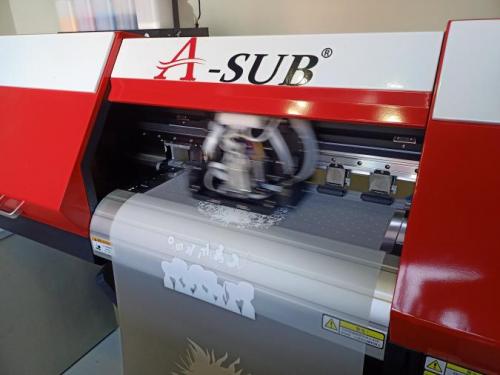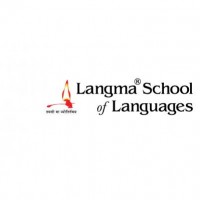What is DTF Film?

DTF film is a kind of new transferring operation. You must be heard of it before in other places. And you must also have many questions about it. This article is writing to introduce DTF film for you in detail. After reading this article, you will know whether the DTF film is suitable for you.
Brief Introduction
DTF film is also named PET heat transfer film. It is a medium material of transfer process. The pattern is printed on the PET heat transfer film, and the ink sticky hot melt powder through the surface of the pattern is used as the transfer medium to transfer on the clothes. Compared with other kinds of transferring operations, it has more advantages such as the price and environmentally friendly. Nowadays, it becomes more popular than before because of its vivid and pretty transferring effects.
Range of Application
The biggest advantage of DTF film is its high compatibility for fabrics. It is compatible with cotton, polyester, and many other kinds of fabrics. The DTF film even can heat transfer on leather, handbags, wallets, and suitcases. And the transferring effect is not less than other kinds of transferring operations. Many manufacturers who have high standard to their products prefer to use DTF film. What’s more, the environmentally friendly handling and ease of operation allows DTF film to be used in a variety of industries, factories, stores, and individual stores, etc.
Operation
There are a lot of differences between DTF film and the other kinds of papers during the process of transferring. The passages below will tell you more detailed information about the operation of DTF film.
Materials & Machines
When we use DTF film to transfer, we need to prepare materials and machines. They are DTF film, powder, DTF ink, a special modified printer, an oven, and a heat press machine. Also, if you have interested in all-in-one machine, you can try A-sub DTF printer & powder shaker.
DTF film
DTF film is made of PET. There are two kinds of DTF film, single-sided and double-sided. A-sub DTF film has diverse sizes to transfer like its sublimation paper. When it is printed, the image area will be sticky. This area is used to stick the powder. As a result, the DTF film doesn’t need to use a cutting machine to cut its image after printing. It will save a lot of time during the process of producing.
Powder
The powder is an media which can make the images stick to the substrates. You can regard it as powdered glue. The powder will fully cover the image which is printed right now. Then the covered film can be sent to the oven to heat. After heating, the powder will melt as a layer. This layer will help the images stick to the substrates during the process of heat transferring.
DTF ink
DTF ink is thicker than normal ink. Only this kind of ink can provide the image higher definition and vivid color. DTF ink’s biggest difference between the other kinds of ink is its white ink. The special white ink is used to as the base color of the pattern. This can make the images have no chromatic aberration. The ink will hardly sublimate and is not sensitive to solvents. This means the DTF ink has high color fastness.
Printer
Unlike the piezo inkjet printer, the foam type printer will change the ink during the process of printing. As a result, we usually use Epson and Sawgrass printers instead of HP and Canon printers. Before we use the printer to print, we must modify the nozzle of the printer. Normally, the nozzle of the printer will be very precise. And the DTF ink is thicker than the normal ink. Only the modified nozzle will be suitable for the DTF ink and provide more output of the ink.
Oven
The oven used to heat the film must preheat to 140℃-150℃. Or the film will underheated. The film will be heated for 3 to 5 minutes. The layer of powder will melt as a different and smooth layer which is used to stick the images to the substrates.
DTF Printer & Powder Shaker
Except the DTF film and DTF ink, we also have DTF printer & powder shaker. This kind of all-in-one machine can save time and process to a large extent. Also, you should not prepare printer and oven specially. The only disadvantage is its weight. The weight of the all-in-one machine is very heavy.
Heat Press
The heat press should preheat to 160℃-170℃. Then we can tile the substrates with the film and heat for 10~20 seconds. After heating, we need to wait for 3-4 minutes to cool the film with the image.
Operation Steps
First of all, we need to prepare all the materials and machines which referred before. And we should modify the nozzle of the printer before we printing the patterns. The modified nozzle can ensure the high quality of the printing.
After printing, we need to fully spray the powder on average right now after printing and shake the over sprayed powder down.
Thirdly, put the film into the oven to heat the powder on it at 140℃-150℃for 3-5 minutes. Don’t forget to preheat the oven before you heat. Or we can use all-in-one machine to print, spray and melt the powder together.
Finally, use the heat press to heat transfer the image for 10-20 seconds. Preheating the heat press at 160℃-170℃ helps the image be transferred to the substrates better. The most important thing is tearing the film after cooling it for 3-4 minutes.
Operation Peculiarity
The biggest differences between DTF and other printing operations are its powder and white ink. On the one hand, the powder is used to stick the pattern to the substrates. Stable viscosity makes the substrate and pattern more solid. And we don’t need to worry that we will tear the pattern during the process of washing or pulling. On the other hand, the white ink makes the patterns with their bottom color. And the pattern will have no chromatic aberration after transferring to the substrates. The selection of substrate’s color and fabric will not be limited. For the powder and white ink, the operation has differences with others.
Advantages for Printing
Nowadays, why many people prefer to get it a try? There are a few advantages for DTF printing. We will show you more detailed descriptions below.
Fabric Compatibility
DTF film can be used on all kinds of dark and light color canvas, cotton T-shirts, row undershirt, denim, nylon, etc. This makes the manufacturers have more choices in fabrics. They will not be limited by fabrics or must buy special paper to heat transfer different kinds of fabrics. As a result, DTF saves the manufacturers’ time and money to a large extent.
Vivid Color & Color Fastness
DTF must use modified printer. The modified nozzle of the printer allows more output of the thicker ink than before. More output and thicker ink provides the pattern with more vivid color and sharpness without chromatic aberration than before. The DTF ink is also not sensitive to solvents. We don’t need to worry about the pattern when it be washed. The fastness of the pattern is also so excellent that it can be tore and rubbed without damage.
Clear Pattern
On the one hand, the modified nozzle which provides enough ink helps the pattern to be clear. On the other hand, the white ink is also of great significance to the DTF. The white ink printed on the bottom of the pattern makes the pattern not covered by the original color of the substrates.
No Cutting Machine
The DTF film doesn’t need to use the cutting machine. When printing the DTF film, only the area of pattern will be sticky. Normally, we will stray the powder to the pattern quickly after printing. The powder will fully cover the pattern on average and used to stick the pattern to the substrates. When heat transferring, only the pattern with powder will be transferred to the substrates. As a result, we don’t need to cutting the film before transferring.
Price & Volume
We used to calculate the cost of consumables. It was concluded that the cost of consumables per square meter does not exceed $3.60. Normally, we provide diverse sizes of DTF film. The most used are rolled DTF films. DTF film’s good value for money makes merchants more willing to try it.
Disadvantages for Printing
There are some not-so-convenient aspects in the use of DTF film. We will introduce this to provide a better reference for businessmen.
Air Permeability
After you finish the heat transferring, you can see the pattern transferred to the substrates is a film. As a result, the area transferred will not breathe. To some extent, if we are heat transferring the clothing, the large area of pattern will influence the air permeability of the clothing. If the substrates don’t need to worry about the air permeability, you can absolutely choose DTF to transferring.
Slightly Complicated Process
Compared with other transferring operations, the DTF’s process may be a little complicated. In addition, it need to be put in the oven to heat the powder. Of course, we recommend you to use our all-in-one machine to print and shake powder. The things you need to do is only putting the film in and filling the ink. Then, you can wait to get the film heated well with powder and start your transferring.
Conclusion
DTF is a new transferring operation. It solves many questions about the limitation of fabrics and colors. With DTF film, the manufacturers don’t need to worry about the colors and fabrics of the substrates during the process of transferring. DTF provides manufacturers more choices about transferring and saves more time and money. Moreover, the effect of DTF transferring is more pretty and vivid obviously.
Post Your Ad Here

Comments